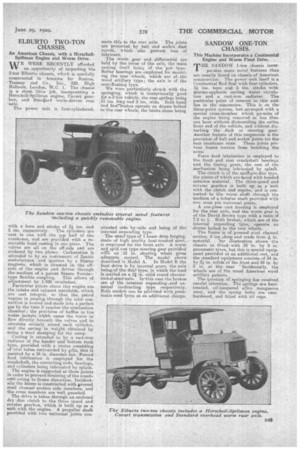ELBURTO TWO-TON CHASSIS.
Page 31

If you've noticed an error in this article please click here to report it so we can fix it.
An American Chassis, with a Herschel!Spillman Engine and Worm Drive.
WE WERE RECENTLY afforded an opportunity of inspecting the 2-ton Elburto chassis, which is specially constructed in America for Bourne, ' Toomey and Co., Inc., 329, High Holborn, London, W.C. 1. The chassis is a stout little job, incorporating a Herschell-Spillman engine, Covert gearbox, and Stan4ard worm-driven rear axle.
The power unit is four-eylindered,
with a bore and stroke of 34 ins. and 5 ins. respectively. The cylinders are cast in one with the top half of the crankcase, and are provided with a removable head casting in one piece. The valves are all an the off-side and are enclosed by two plates. Carburation is attended to by an instrument of Zenith manufacture, and ignition by a Simms magneto, which is situated on the offside of the engine and driven through the medium of a patent Simms Vernier
type flexible coupling. This allows of adjustment by 1-380 revolution.
Particular points about this engine are the intake and exhaust manifolds, which are east integral. SO' that the petrol vapour in passing through the inlet connection is heated and made into a perfect gas by the time it reaches the combustion chamber; the provision of baffles in the water jackets which cause the water to flow directly beneath the valves and to circulate entirely reund each cylinder, an i d the saving n weight obtained by 4ising a steel stamping for the sump. Cooling is attended to by a cast-iron radiator of the header and bottom tank type, provided with a centre consisting a oval tubes surrounded by gills, this is assisted by a 16 in, diameter fan. Forced feed lubrication is employed for the crankshaft, the connecting rods, bearings, and cylinders being lubricated by splash.
The engine is supported at three points in order to prevent, straining of the crankces'e owing to frame distortion. Incidentally the frame is constructed with pressed steel channel section side members, and the cross members are well gusseted. The drive is taken through an enclosed dry .disc clutch to the three speed and reverse gearbox, which is built up as a unit with the engine. A propeller shaft provided with two universal joints con
nects this to the rear axle. The joints are Protected by ball and socket dust covers, which also prevent loss of lubricant.
The worm gear and differential are held by the cover of the axle, the main casting itself being of the pot type. Roller bearings are employed for mounting the rear wheels, which are of the wood artillery type; the axle is of the semi-floating type. We were particularly struck with the springing, which is exceptionally good for a.2-ton vehicle, the rear springs being 51 ins. long and 3 ins. wide. Both hand and foot—brakes operate on drums bolted to the rear wheels, the brake shoes being
situated side byeside and being of the internal expanding type.
The usua1 type of 1-beam drop forging, made of high quality heat-treated steel, is employed for the front axle. A worm and split nut type steering gear provided win. an 18 in. steering wheel gives adequate control. The model above described is Msxlel A. In Model B the final drive is by internal gears, the axle being4 the dual type, in whiah the load is carried on a 21 in. solid rountrehromenickel-steel-axle. Insthis case the brakes are of the internal expandingsand external contracting type respectively. Both models can be provided with•pneumatic cord tyres at an additional charge.
SANDOW ONE-TON CHASSIS.
This Machine Incorporates a Continental Engine and Worm Final Drive. ,
THE SANDOW 1-ton chassis incorporates more novel features than are usually found on chassis of American construction. The power unit itself is a Continental Red Seal with four cylinders, 31 ins, bore arid 5 ins. strohe with tibermo-syplsonic cooling water circulation and a cast-iron radiator. The particular point of interest in this unit lies in the suspension. This is on the throe-point system, but arranged with a special cross-member which permits of the engine being removed in less than one hour without dismounting the entire front end of the vehicle, and without disturbing the dash or steering gear. Another feature of this suspension is the provision of ball and socket joints for the rear crankcase arms. These joints prevent frame torsion from breaking the arms.
Force feed lubrication is employed to the front and rear crankshaft bearings and the timing gears, the rest of the mechanism being lubricated by splagh.
The clutch is of the multiple-disc type, the plates of which are faced with bonded asbestos material. The three-speed and reverse gearbox is built up as a unit, with the clutch and engine, and is connected to the worm shalt through the medium of a tubular shaft provided with two cross pin universal joints.
A one-piece cast housing is employed far the rear axle, and the worm gear is of the David Brown type with a ratio of 7.8 to 1. Both brakes which are of the internal expanding type, operate on drums bolted to the rear wheels.
The frame is of pressed steel channel section, 5 ins.,deep and made from elf in. material. Dur illustration shows the chassis as fitted,with 35 in. by 5 in. pneumatic tyres, but this is special equipment provided at an additional cost, and the standard equipment consists of .34in. by 34 in. solids at the front and 34 in. by 5 in. at the rear • Incidentally, the wheels are of the usual American wood artillery pattern.
The question of springing has received careful attention. The springs are heattreated, oil-tempered silico manganese steel, and the spring bolts are casehardened, and fitted with ail cups.














































